ICT Strategic Management Plan for Mall Bank (NIT2171) Report
VerifiedAdded on 2022/11/13
|12
|2540
|197
Report
AI Summary
This report presents an ICT strategic plan for Mall Bank, a regional bank with 27,000 customers, aiming to address declining cash transactions and increasing electronic transactions. The report analyzes the bank's vision, mission, and objectives, identifying drivers for change such as infrastructure improvements, enhanced data management, mobile device management, customer relationship management, and IT governance. It outlines an ICT roadmap with initiatives categorized into strategic planning, research, SWOT analysis, strategic gap identification, target development, project planning, and implementation. Three key ICT strategic themes are explored: technologies and human usability, technology in knowledge sharing, and ubiquitous learning, each with relevant ICT capabilities. The report offers insights into improving the bank's operations through technology, customer service, and security.
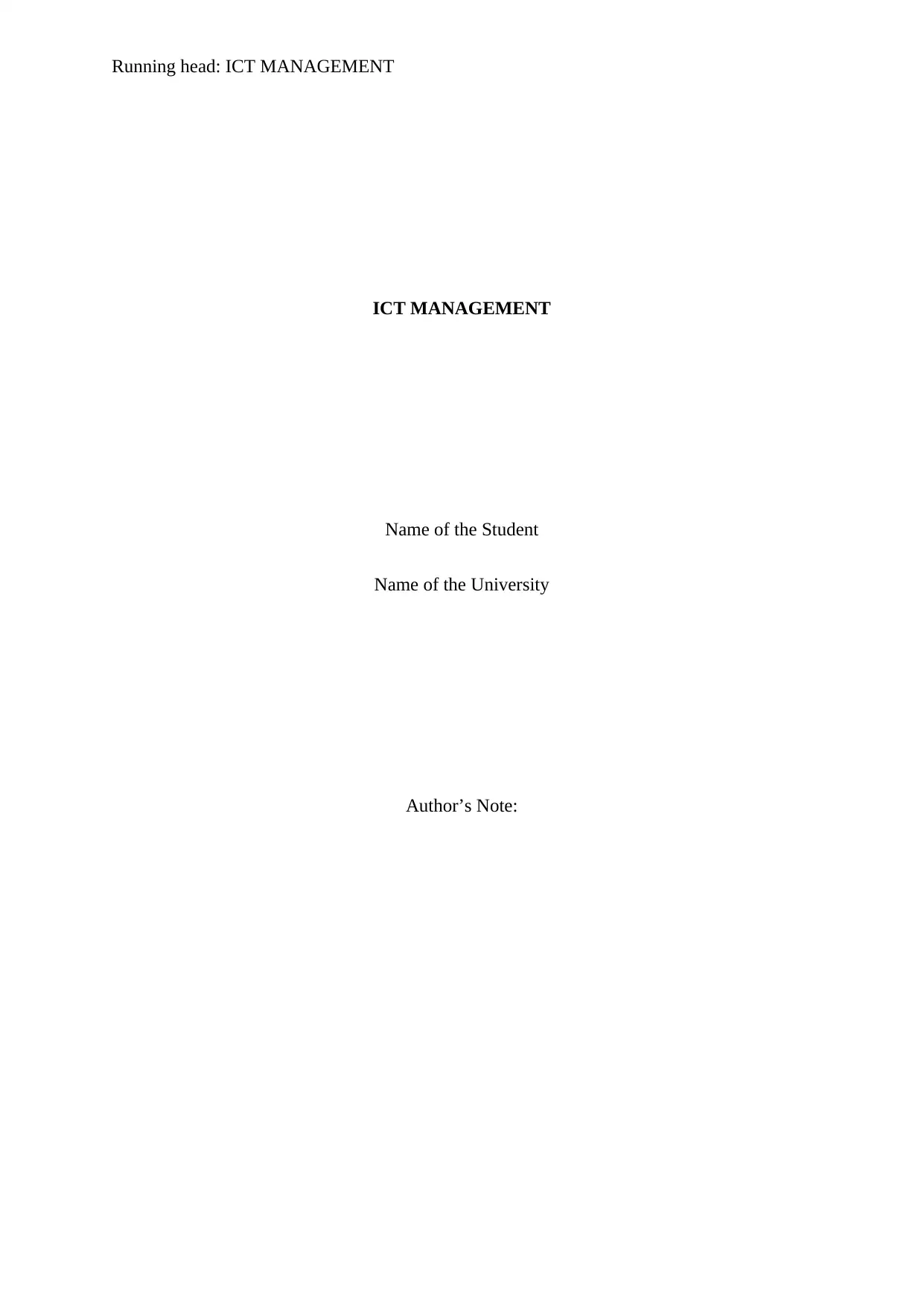
Running head: ICT MANAGEMENT
ICT MANAGEMENT
Name of the Student
Name of the University
Author’s Note:
ICT MANAGEMENT
Name of the Student
Name of the University
Author’s Note:
Paraphrase This Document
Need a fresh take? Get an instant paraphrase of this document with our AI Paraphraser
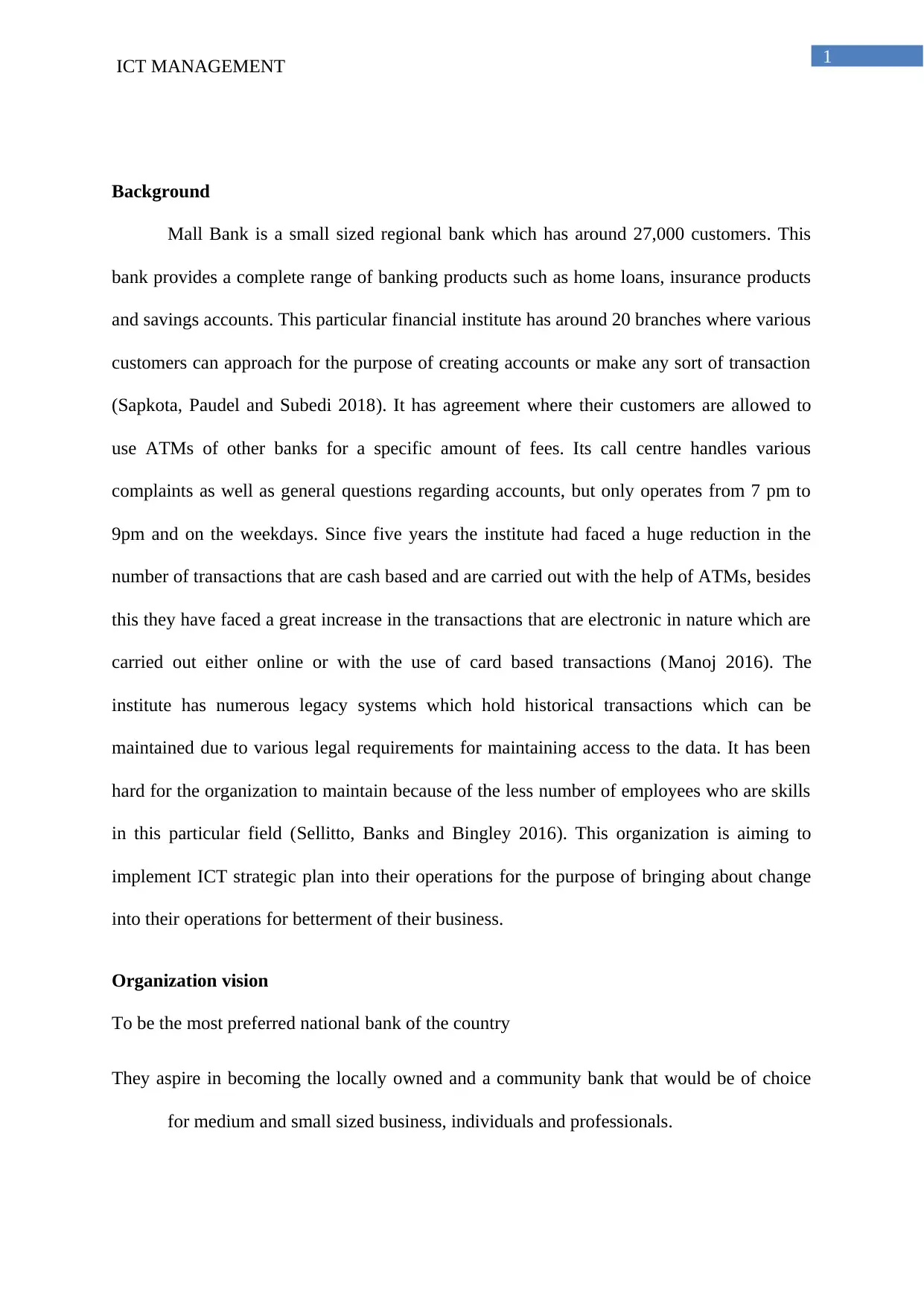
1
ICT MANAGEMENT
Background
Mall Bank is a small sized regional bank which has around 27,000 customers. This
bank provides a complete range of banking products such as home loans, insurance products
and savings accounts. This particular financial institute has around 20 branches where various
customers can approach for the purpose of creating accounts or make any sort of transaction
(Sapkota, Paudel and Subedi 2018). It has agreement where their customers are allowed to
use ATMs of other banks for a specific amount of fees. Its call centre handles various
complaints as well as general questions regarding accounts, but only operates from 7 pm to
9pm and on the weekdays. Since five years the institute had faced a huge reduction in the
number of transactions that are cash based and are carried out with the help of ATMs, besides
this they have faced a great increase in the transactions that are electronic in nature which are
carried out either online or with the use of card based transactions (Manoj 2016). The
institute has numerous legacy systems which hold historical transactions which can be
maintained due to various legal requirements for maintaining access to the data. It has been
hard for the organization to maintain because of the less number of employees who are skills
in this particular field (Sellitto, Banks and Bingley 2016). This organization is aiming to
implement ICT strategic plan into their operations for the purpose of bringing about change
into their operations for betterment of their business.
Organization vision
To be the most preferred national bank of the country
They aspire in becoming the locally owned and a community bank that would be of choice
for medium and small sized business, individuals and professionals.
ICT MANAGEMENT
Background
Mall Bank is a small sized regional bank which has around 27,000 customers. This
bank provides a complete range of banking products such as home loans, insurance products
and savings accounts. This particular financial institute has around 20 branches where various
customers can approach for the purpose of creating accounts or make any sort of transaction
(Sapkota, Paudel and Subedi 2018). It has agreement where their customers are allowed to
use ATMs of other banks for a specific amount of fees. Its call centre handles various
complaints as well as general questions regarding accounts, but only operates from 7 pm to
9pm and on the weekdays. Since five years the institute had faced a huge reduction in the
number of transactions that are cash based and are carried out with the help of ATMs, besides
this they have faced a great increase in the transactions that are electronic in nature which are
carried out either online or with the use of card based transactions (Manoj 2016). The
institute has numerous legacy systems which hold historical transactions which can be
maintained due to various legal requirements for maintaining access to the data. It has been
hard for the organization to maintain because of the less number of employees who are skills
in this particular field (Sellitto, Banks and Bingley 2016). This organization is aiming to
implement ICT strategic plan into their operations for the purpose of bringing about change
into their operations for betterment of their business.
Organization vision
To be the most preferred national bank of the country
They aspire in becoming the locally owned and a community bank that would be of choice
for medium and small sized business, individuals and professionals.
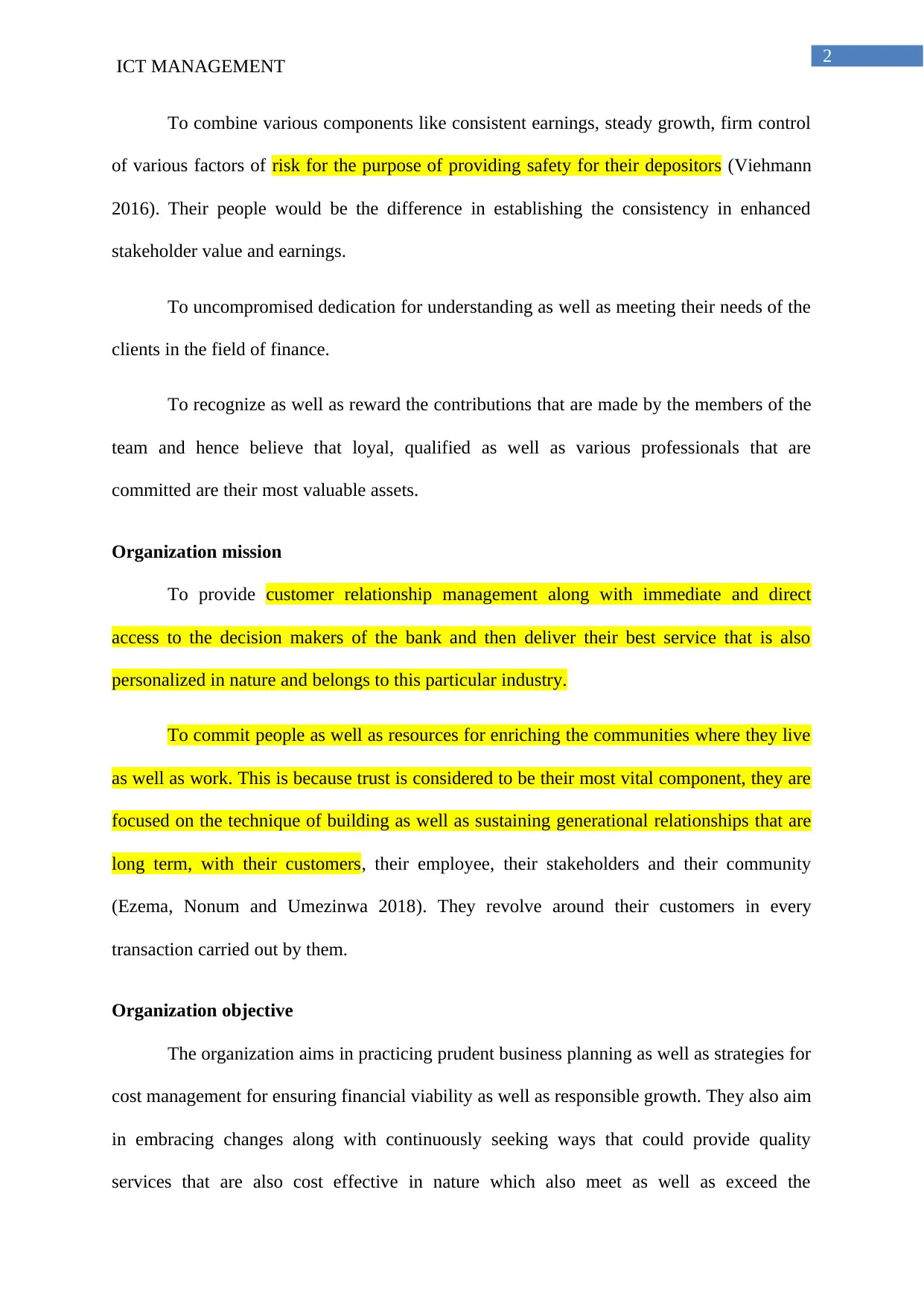
2
ICT MANAGEMENT
To combine various components like consistent earnings, steady growth, firm control
of various factors of risk for the purpose of providing safety for their depositors (Viehmann
2016). Their people would be the difference in establishing the consistency in enhanced
stakeholder value and earnings.
To uncompromised dedication for understanding as well as meeting their needs of the
clients in the field of finance.
To recognize as well as reward the contributions that are made by the members of the
team and hence believe that loyal, qualified as well as various professionals that are
committed are their most valuable assets.
Organization mission
To provide customer relationship management along with immediate and direct
access to the decision makers of the bank and then deliver their best service that is also
personalized in nature and belongs to this particular industry.
To commit people as well as resources for enriching the communities where they live
as well as work. This is because trust is considered to be their most vital component, they are
focused on the technique of building as well as sustaining generational relationships that are
long term, with their customers, their employee, their stakeholders and their community
(Ezema, Nonum and Umezinwa 2018). They revolve around their customers in every
transaction carried out by them.
Organization objective
The organization aims in practicing prudent business planning as well as strategies for
cost management for ensuring financial viability as well as responsible growth. They also aim
in embracing changes along with continuously seeking ways that could provide quality
services that are also cost effective in nature which also meet as well as exceed the
ICT MANAGEMENT
To combine various components like consistent earnings, steady growth, firm control
of various factors of risk for the purpose of providing safety for their depositors (Viehmann
2016). Their people would be the difference in establishing the consistency in enhanced
stakeholder value and earnings.
To uncompromised dedication for understanding as well as meeting their needs of the
clients in the field of finance.
To recognize as well as reward the contributions that are made by the members of the
team and hence believe that loyal, qualified as well as various professionals that are
committed are their most valuable assets.
Organization mission
To provide customer relationship management along with immediate and direct
access to the decision makers of the bank and then deliver their best service that is also
personalized in nature and belongs to this particular industry.
To commit people as well as resources for enriching the communities where they live
as well as work. This is because trust is considered to be their most vital component, they are
focused on the technique of building as well as sustaining generational relationships that are
long term, with their customers, their employee, their stakeholders and their community
(Ezema, Nonum and Umezinwa 2018). They revolve around their customers in every
transaction carried out by them.
Organization objective
The organization aims in practicing prudent business planning as well as strategies for
cost management for ensuring financial viability as well as responsible growth. They also aim
in embracing changes along with continuously seeking ways that could provide quality
services that are also cost effective in nature which also meet as well as exceed the
⊘ This is a preview!⊘
Do you want full access?
Subscribe today to unlock all pages.

Trusted by 1+ million students worldwide
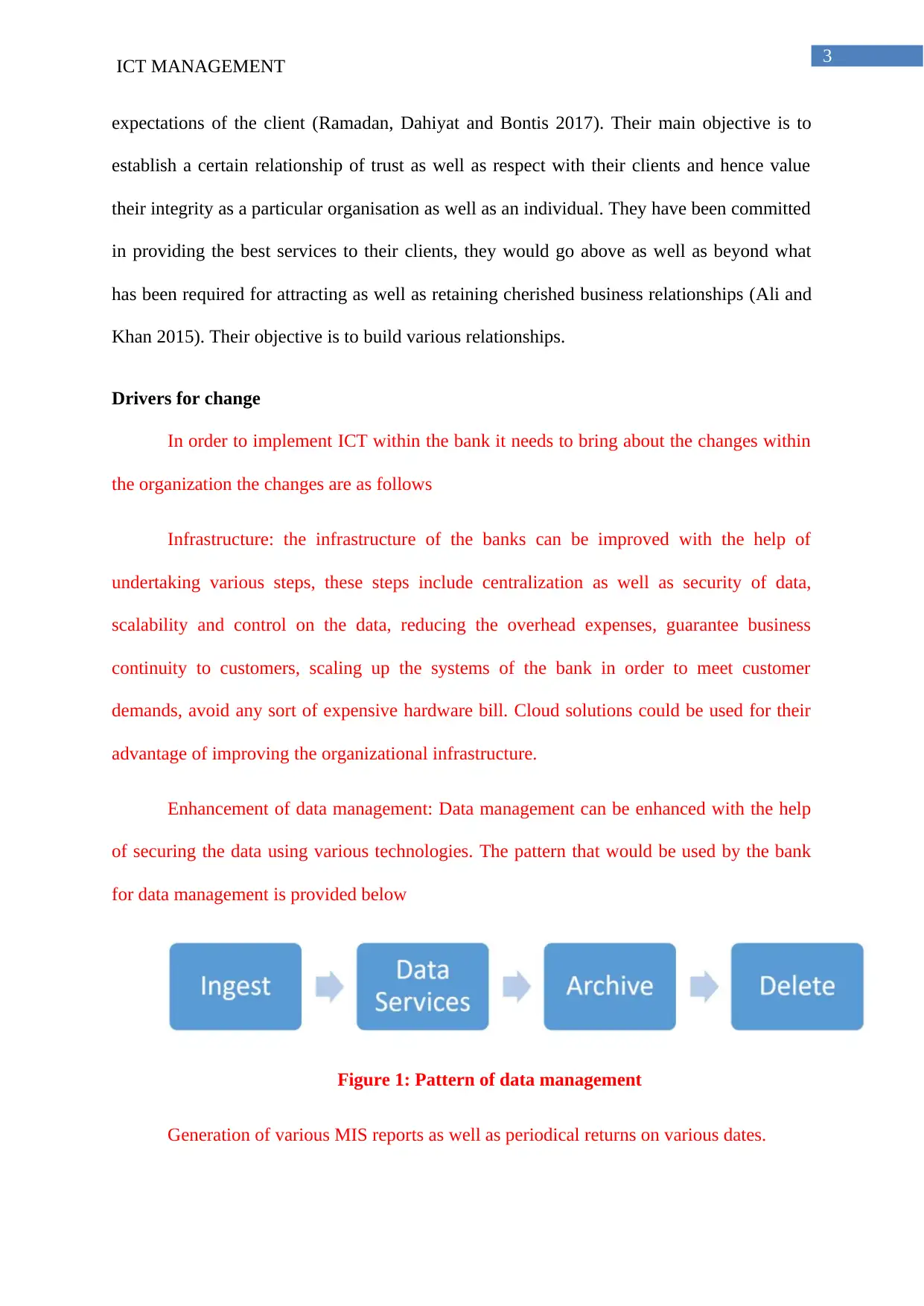
3
ICT MANAGEMENT
expectations of the client (Ramadan, Dahiyat and Bontis 2017). Their main objective is to
establish a certain relationship of trust as well as respect with their clients and hence value
their integrity as a particular organisation as well as an individual. They have been committed
in providing the best services to their clients, they would go above as well as beyond what
has been required for attracting as well as retaining cherished business relationships (Ali and
Khan 2015). Their objective is to build various relationships.
Drivers for change
In order to implement ICT within the bank it needs to bring about the changes within
the organization the changes are as follows
Infrastructure: the infrastructure of the banks can be improved with the help of
undertaking various steps, these steps include centralization as well as security of data,
scalability and control on the data, reducing the overhead expenses, guarantee business
continuity to customers, scaling up the systems of the bank in order to meet customer
demands, avoid any sort of expensive hardware bill. Cloud solutions could be used for their
advantage of improving the organizational infrastructure.
Enhancement of data management: Data management can be enhanced with the help
of securing the data using various technologies. The pattern that would be used by the bank
for data management is provided below
Figure 1: Pattern of data management
Generation of various MIS reports as well as periodical returns on various dates.
ICT MANAGEMENT
expectations of the client (Ramadan, Dahiyat and Bontis 2017). Their main objective is to
establish a certain relationship of trust as well as respect with their clients and hence value
their integrity as a particular organisation as well as an individual. They have been committed
in providing the best services to their clients, they would go above as well as beyond what
has been required for attracting as well as retaining cherished business relationships (Ali and
Khan 2015). Their objective is to build various relationships.
Drivers for change
In order to implement ICT within the bank it needs to bring about the changes within
the organization the changes are as follows
Infrastructure: the infrastructure of the banks can be improved with the help of
undertaking various steps, these steps include centralization as well as security of data,
scalability and control on the data, reducing the overhead expenses, guarantee business
continuity to customers, scaling up the systems of the bank in order to meet customer
demands, avoid any sort of expensive hardware bill. Cloud solutions could be used for their
advantage of improving the organizational infrastructure.
Enhancement of data management: Data management can be enhanced with the help
of securing the data using various technologies. The pattern that would be used by the bank
for data management is provided below
Figure 1: Pattern of data management
Generation of various MIS reports as well as periodical returns on various dates.
Paraphrase This Document
Need a fresh take? Get an instant paraphrase of this document with our AI Paraphraser
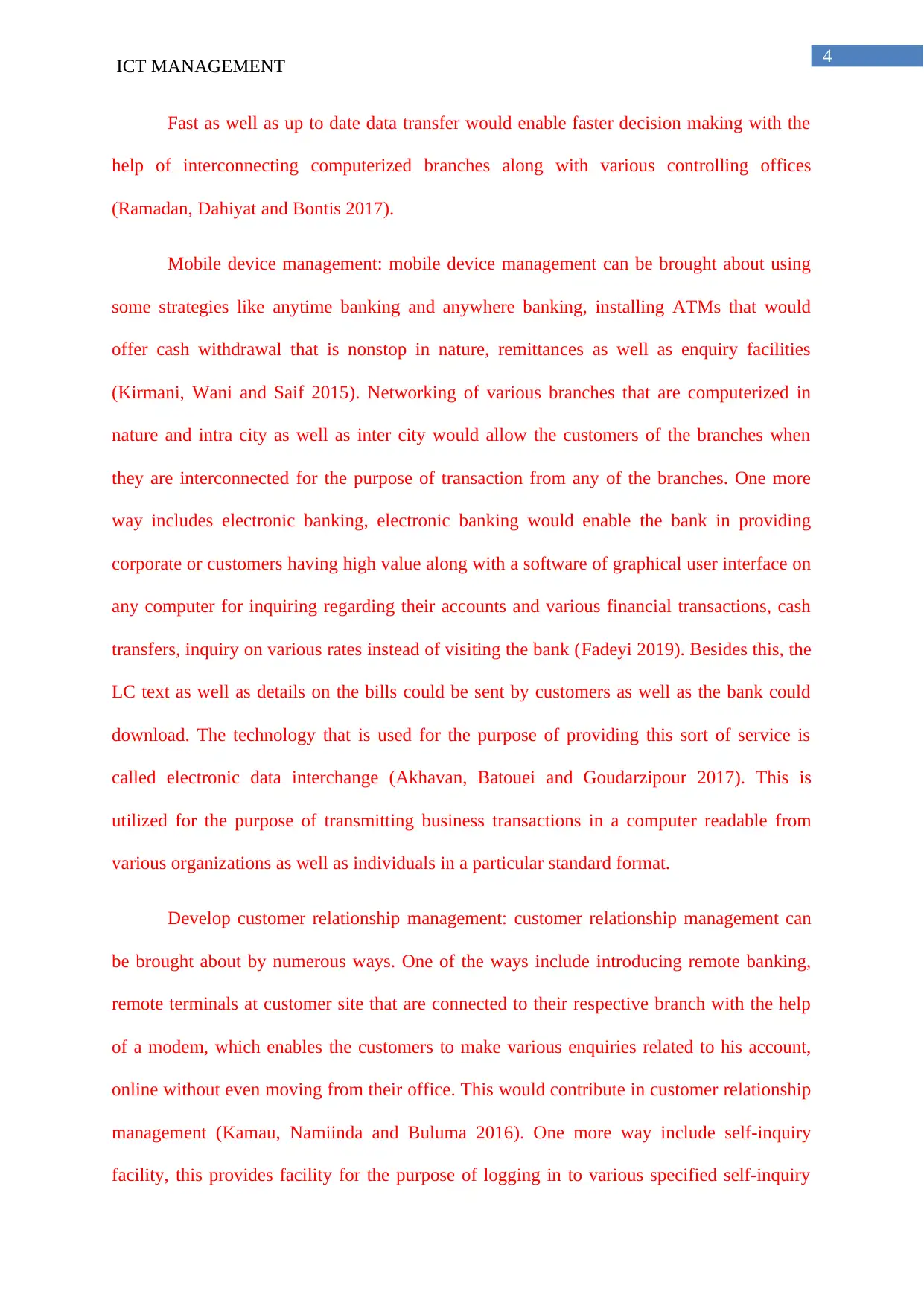
4
ICT MANAGEMENT
Fast as well as up to date data transfer would enable faster decision making with the
help of interconnecting computerized branches along with various controlling offices
(Ramadan, Dahiyat and Bontis 2017).
Mobile device management: mobile device management can be brought about using
some strategies like anytime banking and anywhere banking, installing ATMs that would
offer cash withdrawal that is nonstop in nature, remittances as well as enquiry facilities
(Kirmani, Wani and Saif 2015). Networking of various branches that are computerized in
nature and intra city as well as inter city would allow the customers of the branches when
they are interconnected for the purpose of transaction from any of the branches. One more
way includes electronic banking, electronic banking would enable the bank in providing
corporate or customers having high value along with a software of graphical user interface on
any computer for inquiring regarding their accounts and various financial transactions, cash
transfers, inquiry on various rates instead of visiting the bank (Fadeyi 2019). Besides this, the
LC text as well as details on the bills could be sent by customers as well as the bank could
download. The technology that is used for the purpose of providing this sort of service is
called electronic data interchange (Akhavan, Batouei and Goudarzipour 2017). This is
utilized for the purpose of transmitting business transactions in a computer readable from
various organizations as well as individuals in a particular standard format.
Develop customer relationship management: customer relationship management can
be brought about by numerous ways. One of the ways include introducing remote banking,
remote terminals at customer site that are connected to their respective branch with the help
of a modem, which enables the customers to make various enquiries related to his account,
online without even moving from their office. This would contribute in customer relationship
management (Kamau, Namiinda and Buluma 2016). One more way include self-inquiry
facility, this provides facility for the purpose of logging in to various specified self-inquiry
ICT MANAGEMENT
Fast as well as up to date data transfer would enable faster decision making with the
help of interconnecting computerized branches along with various controlling offices
(Ramadan, Dahiyat and Bontis 2017).
Mobile device management: mobile device management can be brought about using
some strategies like anytime banking and anywhere banking, installing ATMs that would
offer cash withdrawal that is nonstop in nature, remittances as well as enquiry facilities
(Kirmani, Wani and Saif 2015). Networking of various branches that are computerized in
nature and intra city as well as inter city would allow the customers of the branches when
they are interconnected for the purpose of transaction from any of the branches. One more
way includes electronic banking, electronic banking would enable the bank in providing
corporate or customers having high value along with a software of graphical user interface on
any computer for inquiring regarding their accounts and various financial transactions, cash
transfers, inquiry on various rates instead of visiting the bank (Fadeyi 2019). Besides this, the
LC text as well as details on the bills could be sent by customers as well as the bank could
download. The technology that is used for the purpose of providing this sort of service is
called electronic data interchange (Akhavan, Batouei and Goudarzipour 2017). This is
utilized for the purpose of transmitting business transactions in a computer readable from
various organizations as well as individuals in a particular standard format.
Develop customer relationship management: customer relationship management can
be brought about by numerous ways. One of the ways include introducing remote banking,
remote terminals at customer site that are connected to their respective branch with the help
of a modem, which enables the customers to make various enquiries related to his account,
online without even moving from their office. This would contribute in customer relationship
management (Kamau, Namiinda and Buluma 2016). One more way include self-inquiry
facility, this provides facility for the purpose of logging in to various specified self-inquiry
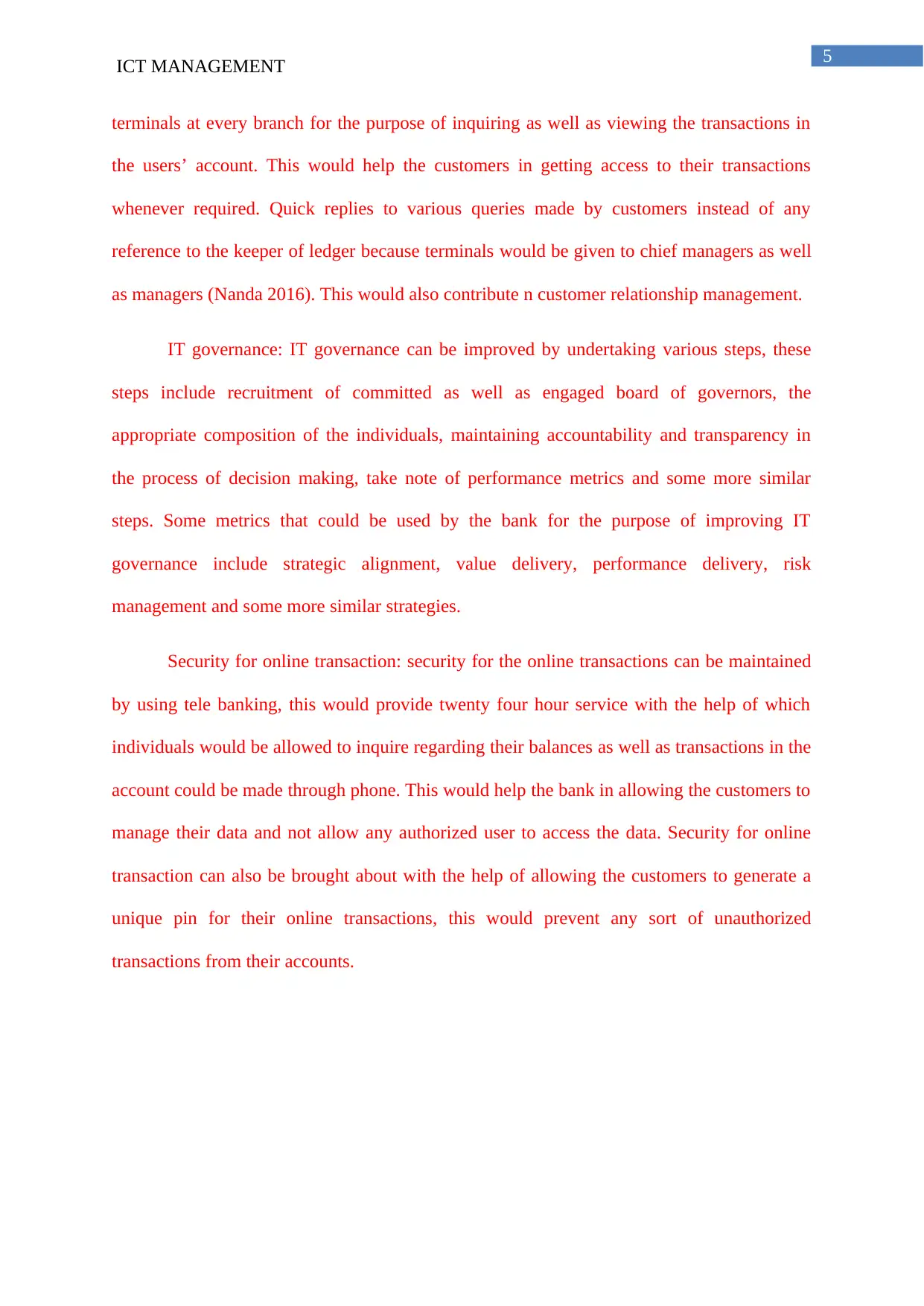
5
ICT MANAGEMENT
terminals at every branch for the purpose of inquiring as well as viewing the transactions in
the users’ account. This would help the customers in getting access to their transactions
whenever required. Quick replies to various queries made by customers instead of any
reference to the keeper of ledger because terminals would be given to chief managers as well
as managers (Nanda 2016). This would also contribute n customer relationship management.
IT governance: IT governance can be improved by undertaking various steps, these
steps include recruitment of committed as well as engaged board of governors, the
appropriate composition of the individuals, maintaining accountability and transparency in
the process of decision making, take note of performance metrics and some more similar
steps. Some metrics that could be used by the bank for the purpose of improving IT
governance include strategic alignment, value delivery, performance delivery, risk
management and some more similar strategies.
Security for online transaction: security for the online transactions can be maintained
by using tele banking, this would provide twenty four hour service with the help of which
individuals would be allowed to inquire regarding their balances as well as transactions in the
account could be made through phone. This would help the bank in allowing the customers to
manage their data and not allow any authorized user to access the data. Security for online
transaction can also be brought about with the help of allowing the customers to generate a
unique pin for their online transactions, this would prevent any sort of unauthorized
transactions from their accounts.
ICT MANAGEMENT
terminals at every branch for the purpose of inquiring as well as viewing the transactions in
the users’ account. This would help the customers in getting access to their transactions
whenever required. Quick replies to various queries made by customers instead of any
reference to the keeper of ledger because terminals would be given to chief managers as well
as managers (Nanda 2016). This would also contribute n customer relationship management.
IT governance: IT governance can be improved by undertaking various steps, these
steps include recruitment of committed as well as engaged board of governors, the
appropriate composition of the individuals, maintaining accountability and transparency in
the process of decision making, take note of performance metrics and some more similar
steps. Some metrics that could be used by the bank for the purpose of improving IT
governance include strategic alignment, value delivery, performance delivery, risk
management and some more similar strategies.
Security for online transaction: security for the online transactions can be maintained
by using tele banking, this would provide twenty four hour service with the help of which
individuals would be allowed to inquire regarding their balances as well as transactions in the
account could be made through phone. This would help the bank in allowing the customers to
manage their data and not allow any authorized user to access the data. Security for online
transaction can also be brought about with the help of allowing the customers to generate a
unique pin for their online transactions, this would prevent any sort of unauthorized
transactions from their accounts.
⊘ This is a preview!⊘
Do you want full access?
Subscribe today to unlock all pages.

Trusted by 1+ million students worldwide
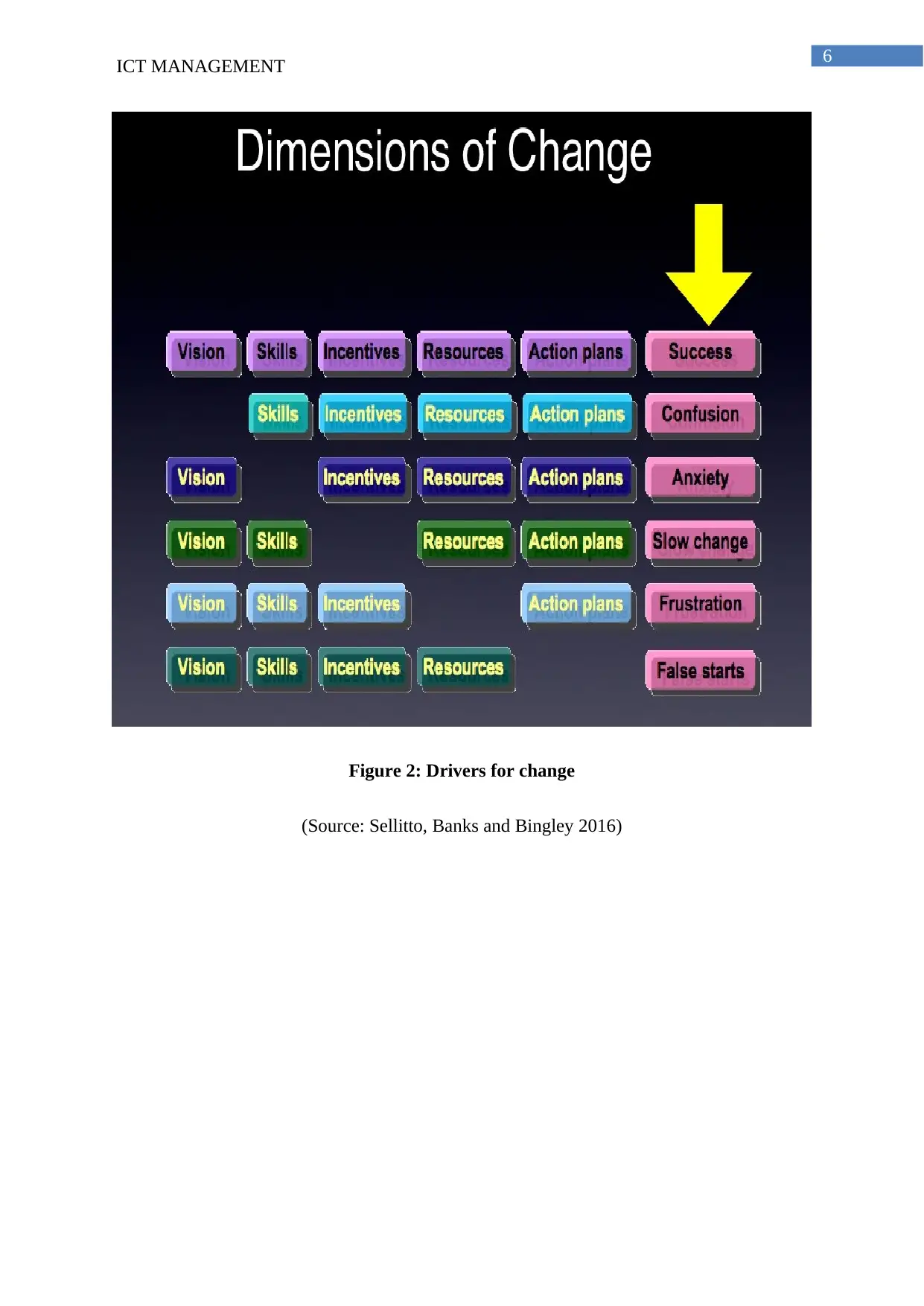
6
ICT MANAGEMENT
Figure 2: Drivers for change
(Source: Sellitto, Banks and Bingley 2016)
ICT MANAGEMENT
Figure 2: Drivers for change
(Source: Sellitto, Banks and Bingley 2016)
Paraphrase This Document
Need a fresh take? Get an instant paraphrase of this document with our AI Paraphraser
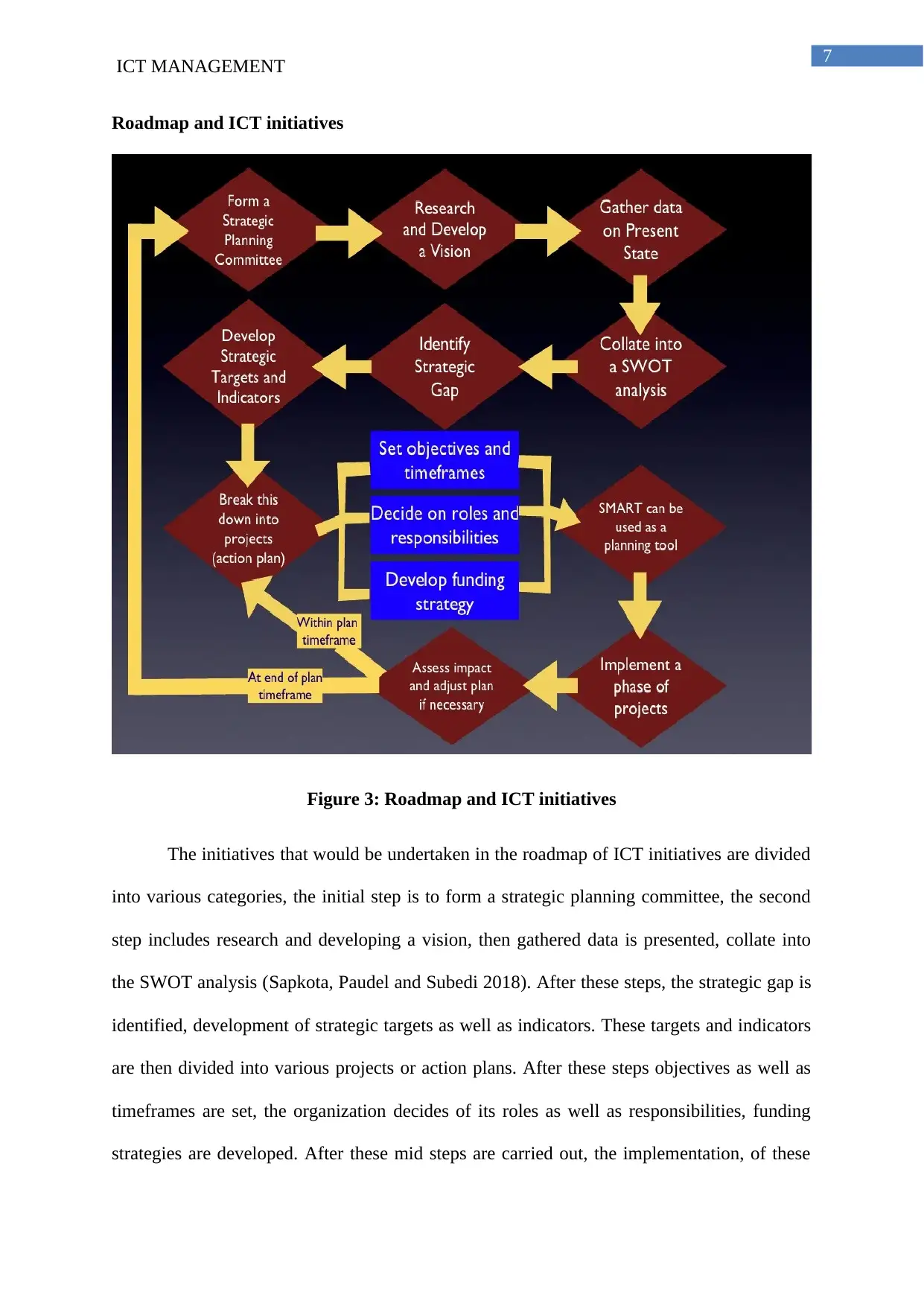
7
ICT MANAGEMENT
Roadmap and ICT initiatives
Figure 3: Roadmap and ICT initiatives
The initiatives that would be undertaken in the roadmap of ICT initiatives are divided
into various categories, the initial step is to form a strategic planning committee, the second
step includes research and developing a vision, then gathered data is presented, collate into
the SWOT analysis (Sapkota, Paudel and Subedi 2018). After these steps, the strategic gap is
identified, development of strategic targets as well as indicators. These targets and indicators
are then divided into various projects or action plans. After these steps objectives as well as
timeframes are set, the organization decides of its roles as well as responsibilities, funding
strategies are developed. After these mid steps are carried out, the implementation, of these
ICT MANAGEMENT
Roadmap and ICT initiatives
Figure 3: Roadmap and ICT initiatives
The initiatives that would be undertaken in the roadmap of ICT initiatives are divided
into various categories, the initial step is to form a strategic planning committee, the second
step includes research and developing a vision, then gathered data is presented, collate into
the SWOT analysis (Sapkota, Paudel and Subedi 2018). After these steps, the strategic gap is
identified, development of strategic targets as well as indicators. These targets and indicators
are then divided into various projects or action plans. After these steps objectives as well as
timeframes are set, the organization decides of its roles as well as responsibilities, funding
strategies are developed. After these mid steps are carried out, the implementation, of these
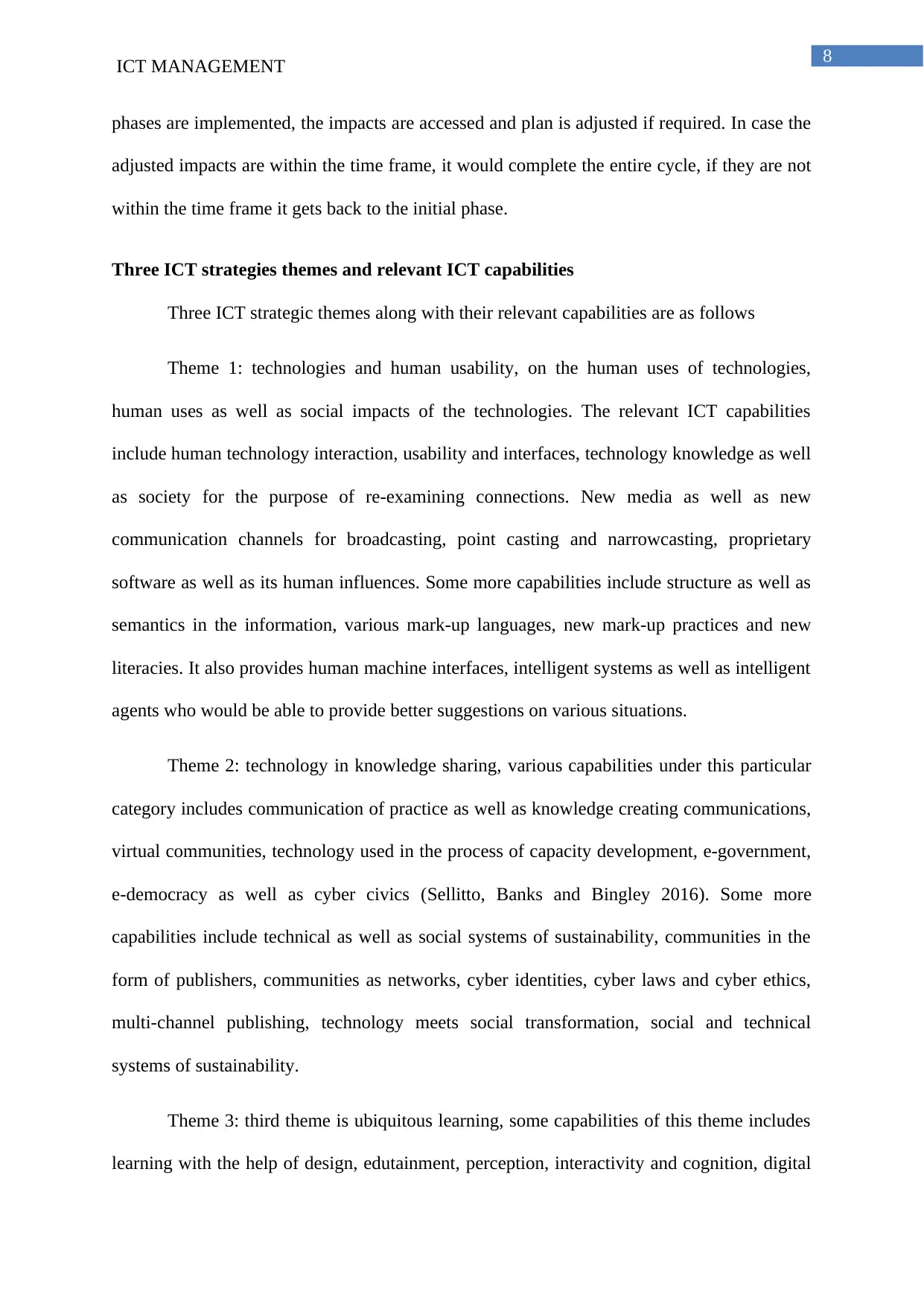
8
ICT MANAGEMENT
phases are implemented, the impacts are accessed and plan is adjusted if required. In case the
adjusted impacts are within the time frame, it would complete the entire cycle, if they are not
within the time frame it gets back to the initial phase.
Three ICT strategies themes and relevant ICT capabilities
Three ICT strategic themes along with their relevant capabilities are as follows
Theme 1: technologies and human usability, on the human uses of technologies,
human uses as well as social impacts of the technologies. The relevant ICT capabilities
include human technology interaction, usability and interfaces, technology knowledge as well
as society for the purpose of re-examining connections. New media as well as new
communication channels for broadcasting, point casting and narrowcasting, proprietary
software as well as its human influences. Some more capabilities include structure as well as
semantics in the information, various mark-up languages, new mark-up practices and new
literacies. It also provides human machine interfaces, intelligent systems as well as intelligent
agents who would be able to provide better suggestions on various situations.
Theme 2: technology in knowledge sharing, various capabilities under this particular
category includes communication of practice as well as knowledge creating communications,
virtual communities, technology used in the process of capacity development, e-government,
e-democracy as well as cyber civics (Sellitto, Banks and Bingley 2016). Some more
capabilities include technical as well as social systems of sustainability, communities in the
form of publishers, communities as networks, cyber identities, cyber laws and cyber ethics,
multi-channel publishing, technology meets social transformation, social and technical
systems of sustainability.
Theme 3: third theme is ubiquitous learning, some capabilities of this theme includes
learning with the help of design, edutainment, perception, interactivity and cognition, digital
ICT MANAGEMENT
phases are implemented, the impacts are accessed and plan is adjusted if required. In case the
adjusted impacts are within the time frame, it would complete the entire cycle, if they are not
within the time frame it gets back to the initial phase.
Three ICT strategies themes and relevant ICT capabilities
Three ICT strategic themes along with their relevant capabilities are as follows
Theme 1: technologies and human usability, on the human uses of technologies,
human uses as well as social impacts of the technologies. The relevant ICT capabilities
include human technology interaction, usability and interfaces, technology knowledge as well
as society for the purpose of re-examining connections. New media as well as new
communication channels for broadcasting, point casting and narrowcasting, proprietary
software as well as its human influences. Some more capabilities include structure as well as
semantics in the information, various mark-up languages, new mark-up practices and new
literacies. It also provides human machine interfaces, intelligent systems as well as intelligent
agents who would be able to provide better suggestions on various situations.
Theme 2: technology in knowledge sharing, various capabilities under this particular
category includes communication of practice as well as knowledge creating communications,
virtual communities, technology used in the process of capacity development, e-government,
e-democracy as well as cyber civics (Sellitto, Banks and Bingley 2016). Some more
capabilities include technical as well as social systems of sustainability, communities in the
form of publishers, communities as networks, cyber identities, cyber laws and cyber ethics,
multi-channel publishing, technology meets social transformation, social and technical
systems of sustainability.
Theme 3: third theme is ubiquitous learning, some capabilities of this theme includes
learning with the help of design, edutainment, perception, interactivity and cognition, digital
⊘ This is a preview!⊘
Do you want full access?
Subscribe today to unlock all pages.

Trusted by 1+ million students worldwide

9
ICT MANAGEMENT
meaning, multiline races and communications, formal as well as informal learning. Learning
organization as well as organizational learning. Life wide along with lifelong learning
ICT MANAGEMENT
meaning, multiline races and communications, formal as well as informal learning. Learning
organization as well as organizational learning. Life wide along with lifelong learning
Paraphrase This Document
Need a fresh take? Get an instant paraphrase of this document with our AI Paraphraser
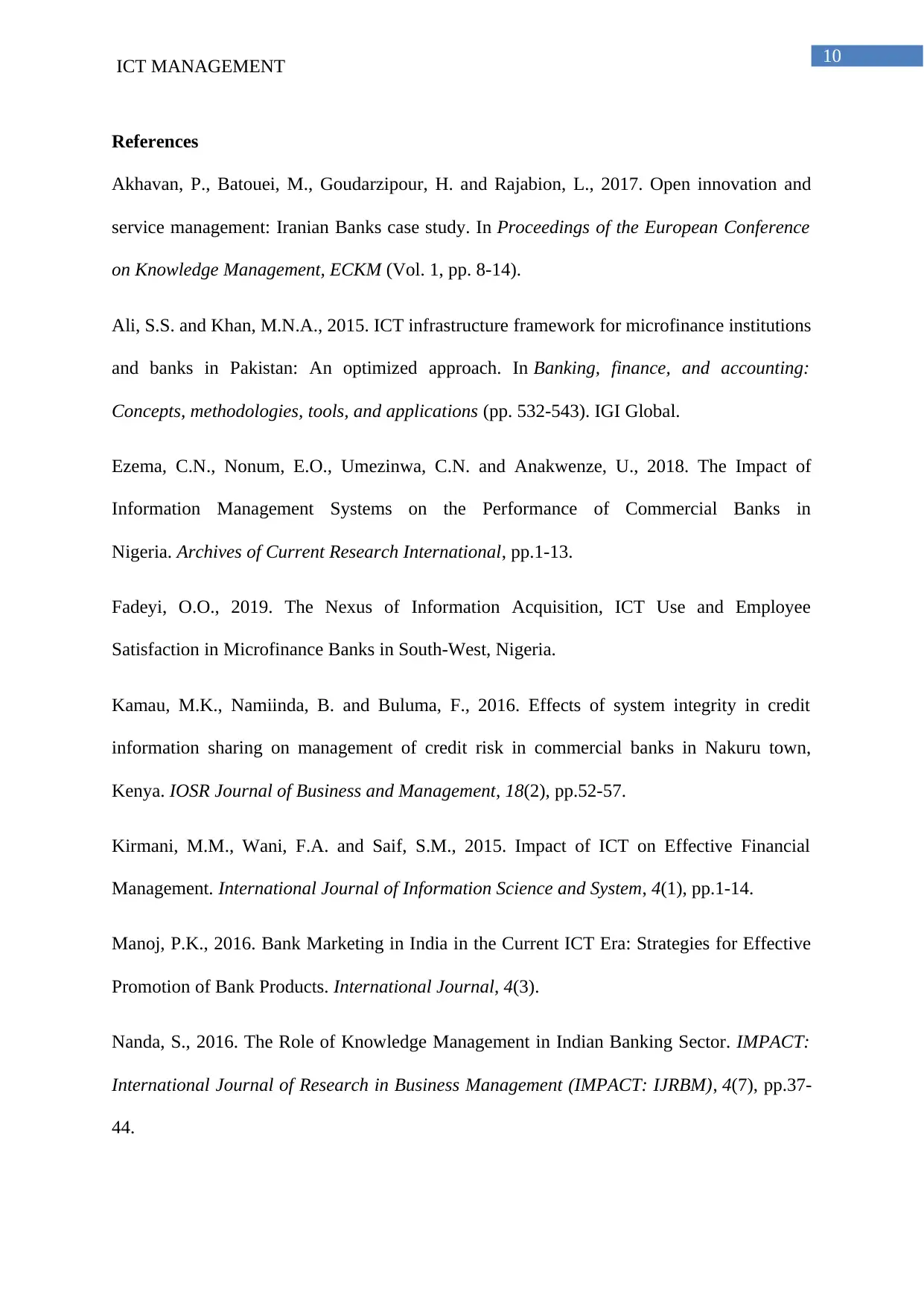
10
ICT MANAGEMENT
References
Akhavan, P., Batouei, M., Goudarzipour, H. and Rajabion, L., 2017. Open innovation and
service management: Iranian Banks case study. In Proceedings of the European Conference
on Knowledge Management, ECKM (Vol. 1, pp. 8-14).
Ali, S.S. and Khan, M.N.A., 2015. ICT infrastructure framework for microfinance institutions
and banks in Pakistan: An optimized approach. In Banking, finance, and accounting:
Concepts, methodologies, tools, and applications (pp. 532-543). IGI Global.
Ezema, C.N., Nonum, E.O., Umezinwa, C.N. and Anakwenze, U., 2018. The Impact of
Information Management Systems on the Performance of Commercial Banks in
Nigeria. Archives of Current Research International, pp.1-13.
Fadeyi, O.O., 2019. The Nexus of Information Acquisition, ICT Use and Employee
Satisfaction in Microfinance Banks in South-West, Nigeria.
Kamau, M.K., Namiinda, B. and Buluma, F., 2016. Effects of system integrity in credit
information sharing on management of credit risk in commercial banks in Nakuru town,
Kenya. IOSR Journal of Business and Management, 18(2), pp.52-57.
Kirmani, M.M., Wani, F.A. and Saif, S.M., 2015. Impact of ICT on Effective Financial
Management. International Journal of Information Science and System, 4(1), pp.1-14.
Manoj, P.K., 2016. Bank Marketing in India in the Current ICT Era: Strategies for Effective
Promotion of Bank Products. International Journal, 4(3).
Nanda, S., 2016. The Role of Knowledge Management in Indian Banking Sector. IMPACT:
International Journal of Research in Business Management (IMPACT: IJRBM), 4(7), pp.37-
44.
ICT MANAGEMENT
References
Akhavan, P., Batouei, M., Goudarzipour, H. and Rajabion, L., 2017. Open innovation and
service management: Iranian Banks case study. In Proceedings of the European Conference
on Knowledge Management, ECKM (Vol. 1, pp. 8-14).
Ali, S.S. and Khan, M.N.A., 2015. ICT infrastructure framework for microfinance institutions
and banks in Pakistan: An optimized approach. In Banking, finance, and accounting:
Concepts, methodologies, tools, and applications (pp. 532-543). IGI Global.
Ezema, C.N., Nonum, E.O., Umezinwa, C.N. and Anakwenze, U., 2018. The Impact of
Information Management Systems on the Performance of Commercial Banks in
Nigeria. Archives of Current Research International, pp.1-13.
Fadeyi, O.O., 2019. The Nexus of Information Acquisition, ICT Use and Employee
Satisfaction in Microfinance Banks in South-West, Nigeria.
Kamau, M.K., Namiinda, B. and Buluma, F., 2016. Effects of system integrity in credit
information sharing on management of credit risk in commercial banks in Nakuru town,
Kenya. IOSR Journal of Business and Management, 18(2), pp.52-57.
Kirmani, M.M., Wani, F.A. and Saif, S.M., 2015. Impact of ICT on Effective Financial
Management. International Journal of Information Science and System, 4(1), pp.1-14.
Manoj, P.K., 2016. Bank Marketing in India in the Current ICT Era: Strategies for Effective
Promotion of Bank Products. International Journal, 4(3).
Nanda, S., 2016. The Role of Knowledge Management in Indian Banking Sector. IMPACT:
International Journal of Research in Business Management (IMPACT: IJRBM), 4(7), pp.37-
44.
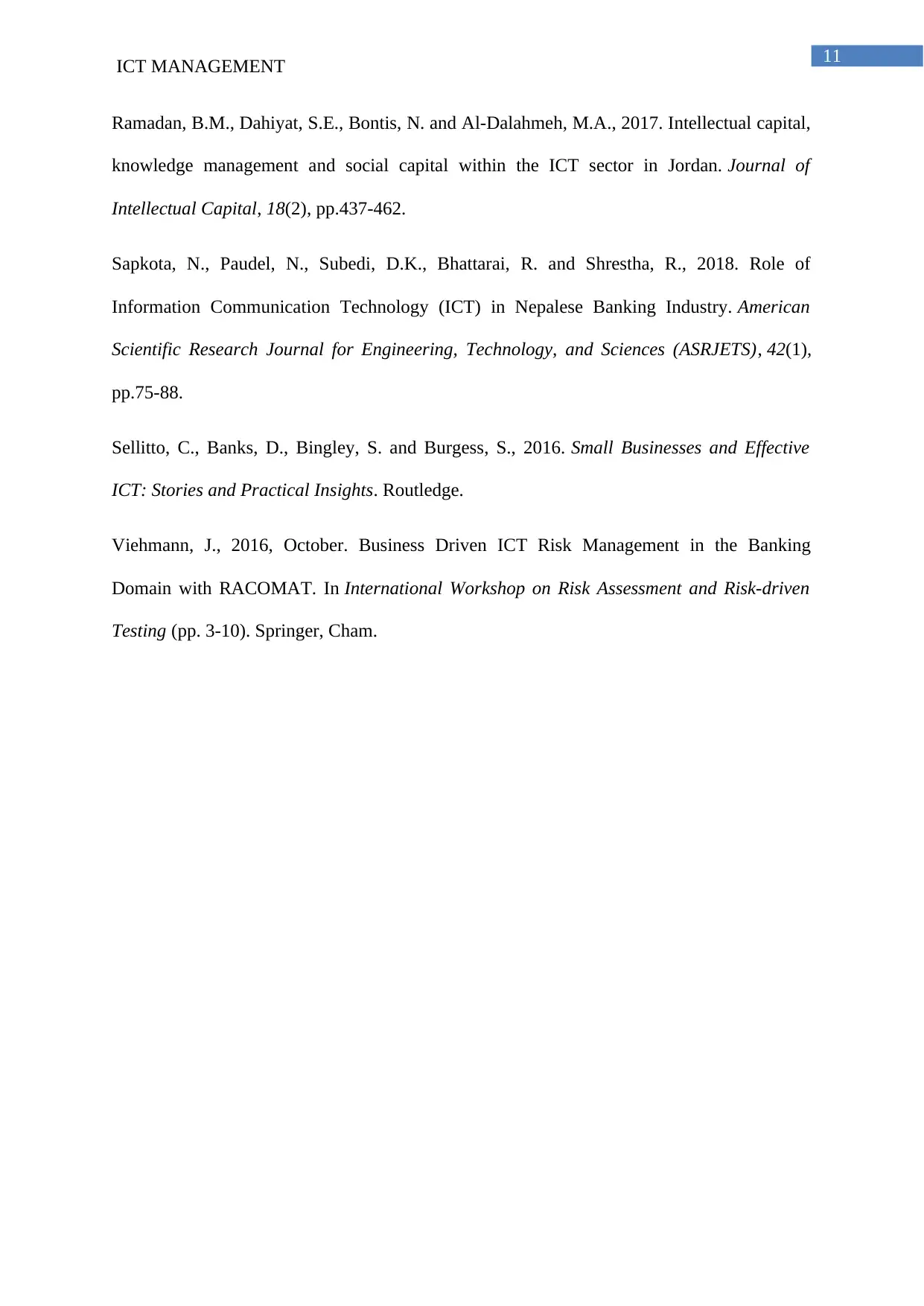
11
ICT MANAGEMENT
Ramadan, B.M., Dahiyat, S.E., Bontis, N. and Al-Dalahmeh, M.A., 2017. Intellectual capital,
knowledge management and social capital within the ICT sector in Jordan. Journal of
Intellectual Capital, 18(2), pp.437-462.
Sapkota, N., Paudel, N., Subedi, D.K., Bhattarai, R. and Shrestha, R., 2018. Role of
Information Communication Technology (ICT) in Nepalese Banking Industry. American
Scientific Research Journal for Engineering, Technology, and Sciences (ASRJETS), 42(1),
pp.75-88.
Sellitto, C., Banks, D., Bingley, S. and Burgess, S., 2016. Small Businesses and Effective
ICT: Stories and Practical Insights. Routledge.
Viehmann, J., 2016, October. Business Driven ICT Risk Management in the Banking
Domain with RACOMAT. In International Workshop on Risk Assessment and Risk-driven
Testing (pp. 3-10). Springer, Cham.
ICT MANAGEMENT
Ramadan, B.M., Dahiyat, S.E., Bontis, N. and Al-Dalahmeh, M.A., 2017. Intellectual capital,
knowledge management and social capital within the ICT sector in Jordan. Journal of
Intellectual Capital, 18(2), pp.437-462.
Sapkota, N., Paudel, N., Subedi, D.K., Bhattarai, R. and Shrestha, R., 2018. Role of
Information Communication Technology (ICT) in Nepalese Banking Industry. American
Scientific Research Journal for Engineering, Technology, and Sciences (ASRJETS), 42(1),
pp.75-88.
Sellitto, C., Banks, D., Bingley, S. and Burgess, S., 2016. Small Businesses and Effective
ICT: Stories and Practical Insights. Routledge.
Viehmann, J., 2016, October. Business Driven ICT Risk Management in the Banking
Domain with RACOMAT. In International Workshop on Risk Assessment and Risk-driven
Testing (pp. 3-10). Springer, Cham.
⊘ This is a preview!⊘
Do you want full access?
Subscribe today to unlock all pages.

Trusted by 1+ million students worldwide
1 out of 12
Related Documents
Your All-in-One AI-Powered Toolkit for Academic Success.
+13062052269
info@desklib.com
Available 24*7 on WhatsApp / Email
![[object Object]](/_next/static/media/star-bottom.7253800d.svg)
Unlock your academic potential
Copyright © 2020–2025 A2Z Services. All Rights Reserved. Developed and managed by ZUCOL.



